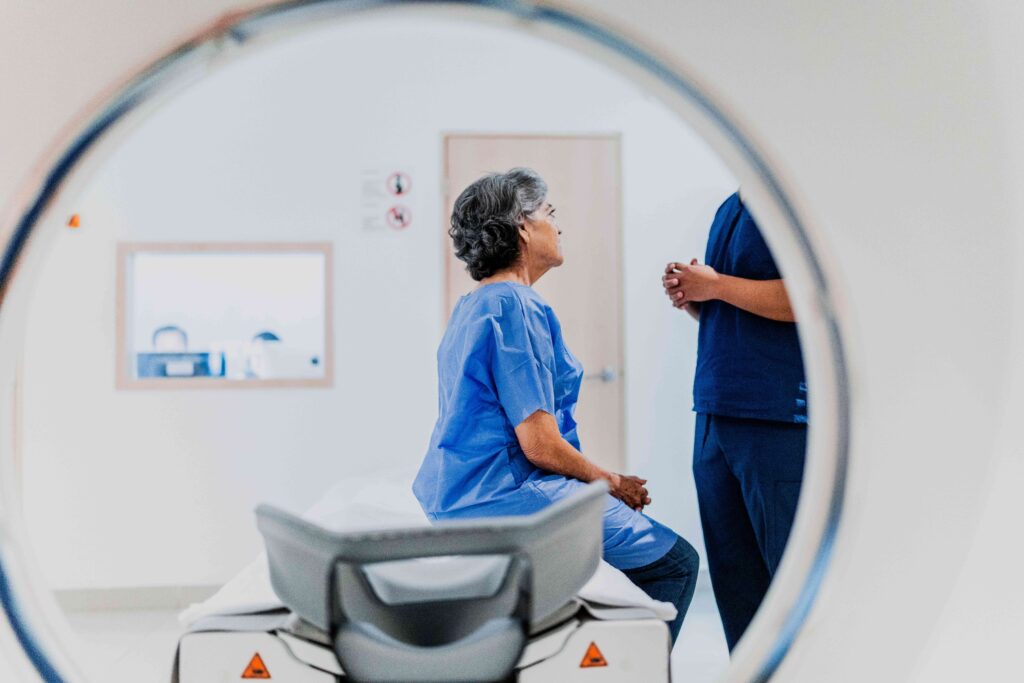:max_bytes(150000):strip_icc():format(jpeg)/Health-GettyImages-1865020912-440cf459fadd46a4b88adfb81a37df61.jpg)
Primary biliary cholangitis (PBC), also known as primary biliary cirrhosis, is a chronic and progressive disease that damages and can eventually destroy the bile ducts of the liver.
Researchers are unsure of the exact causes, but certain risk factors, like being born female or having a family history of PBC, increase your odds of developing it. Of every 100,000 people assigned female at birth, about 58 have this condition, compared to about 15 out of 100,000 people assigned male at birth.
The symptoms of PBC depend on how advanced the case is. The condition can lead to permanent liver damage or liver failure over time. Treatments work to slow the progression of this condition and manage symptoms.
The symptoms of primary biliary cholangitis get worse over time and can vary from person to person. In the earliest stages, there may be no symptoms. In fact, at diagnosis, about 60% of people don’t have any signs of the condition.
Early Signs
In the early stages of primary biliary cholangitis, symptoms occur gradually. The most common initial signs are a feeling of chronic fatigue and pruritus (itchy skin).
Progressive Symptoms
As primary biliary cholangitis progresses, additional symptoms occur. These can include:
- Pain or discomfort in the abdomen
- Arthritis, swelling, and pain in the joints
- Dry, itchy eyes
- Dry mouth
Advanced Symptoms
As the liver damage progresses, PBC causes more severe symptoms, including:
- Jaundice, a yellowing of the skin and whites of the eyes
- Hyperpigmentation, or darkening of the skin
- Edema, or swelling in the feet or ankles
- Xanthomas, yellow bumps (fat buildups) on the skin
- Weight loss
- Ascites, fluid buildup in the abdomen
- Joint and muscular pain
- Dark urine
- Confusion, memory loss, or changes in personality
- Difficulty sleeping
Primary biliary cholangitis occurs when certain white blood cells (lymphocytes) build up in the liver and mistakenly attack the bile ducts.
This starts with inflammation, and the ducts eventually close, leading to bile (digestive fluid) buildup in the liver. Over time, this causes cirrhosis—scarring and tissue damage, impacting this organ’s function.
Researchers are uncertain what causes this immune response but believe it to be an autoimmune reaction triggered by environmental and genetic factors. Certain genes raise your risk of developing the condition. Environmental triggers include exposure to specific toxins, nail polish, or hair dye, smoking, and certain infections, such as urinary tract infections (UTIs).
Risk Factors
Several factors raise your chances of developing primary biliary cholangitis. These include if you:
- Have a family history of PBC
- Were assigned female at birth
- Are a middle adult age, with most cases affecting those 30-60 years old
- Have European ancestry, as white people are at higher risk than other races
Primary biliary cholangitis is diagnosed based on your medical history, symptoms, and clinical tests. Healthcare providers look to rule out other liver disorders, such as biliary obstruction, hepatitis, primary sclerosing cholangitis (a chronic inflammation of the bile ducts), and liver disease due to drugs or medications.
Alongside your medical history, your healthcare provider may perform several diagnostic tests. These tests include:
- Antimitochondrial antibodies (AMA): This clinical test screens for AMA in blood samples, which is present in 95% of those with primary biliary cholangitis.
- Liver tests: Levels of liver enzymes, particularly elevated alkaline phosphatase (ALP) in the blood, indicate bile duct inflammation or obstruction.
- Cholesterol: Elevated cholesterol levels may be a symptom of primary biliary cholangitis.
- Imaging: Healthcare providers use X-ray, ultrasound, or specialized imaging methods like magnetic resonance cholangiopancreatography (MRCP) to screen for signs of duct obstruction, rule out other causes of symptoms, or assess disease progress.
- Liver biopsy: To confirm cases, identify other causes, and screen affected areas, healthcare providers use minimally invasive techniques to collect liver tissue samples for clinical analysis.
Stages of PBC
Your healthcare provider may stage the disease after evaluating your tests and biopsy results. These stages include the following:
- Stage 1: Also known as the portal stage, stage one includes signs of inflammation and structural changes around the ducts of the liver.
- Stage 2: The second stage is characterized by scarring surrounding the duct. There may also be inflammation at the ducts that prevent them from sealing off entirely.
- Stage 3: Also known as the septal stage, the damaged cells affect the structure of the liver, and scar tissue is more widespread.
- Stage 4: In the final stage, there’s complete cirrhosis. The liver develops nodules (growths), and scar tissue persists, leading to necrosis and cellular death.
There’s no cure for primary biliary cholangitis, so treatments focus on slowing its progress and managing associated symptoms, especially itching. Here are some potential treatments healthcare providers may recommend.
Medications for the Condition
Some prescribed medications work to slow the progression of the disease. These include:
- Urso (ursodiol): This medication is in a class that breaks down gallstones. Urso doesn’t reverse liver damage but can improve bile flow. It also slows disease progression and is often the primary therapy.
- Ocaliva (obeticholic acid): Alone or alongside Urso, Ocaliva may slow the scarring of the liver and promote better function. However, it isn’t effective against symptoms.
- Tricor (fenofibrate): Taken alongside Urso, Tricor may reduce symptoms like itching and reduce inflammation in the liver. Researchers believe it may also make bile less toxic.
- Budesonide: This corticosteroid may be beneficial when taken alongside Urso. Researchers found improved liver markers in those attempting this dual therapy.
Medications for Symptoms
Some medications can help tackle itching, pain, and other symptoms. These include:
- Antihistamines: Anti-itch medications like Claritin (loratadine) and Benadryl (diphenhydramine) are available over the counter (OTC), while Atarax (hydroxyzine hydrochloride) is prescription only.
- Rifadin (rifampin): Rifadin is an antibiotic that can also help ease itching, though researchers don’t understand the mechanism of why it helps.
- Opioid antagonists: Opioid antagonists, such as Narcan (naloxone) and Vivitrol (naltrexone), can also reduce itching associated with liver disease.
- Zoloft (sertraline): Zoloft, an antidepressant, is a selective serotonin reuptake inhibitor (SSRI). It can also reduce itching.
- Diuretics: Also known as water pills, diuretics can help treat fluid buildup in the abdomen due to this condition.
Portal Hypertension Treatment
Scarring due to primary biliary cholangitis can affect blood flow, leading to hypertension (high blood pressure) in the portal vein. This causes edema (swelling in the feet and ankles), ascites (fluid buildup in the abdomen), and enlarged veins.
Treatments for these complications may include limiting salt intake, taking diuretics, and endoscopic surgery to drain excess fluid from the abdomen.
Liver Transplant
If medications are not helping, and the primary biliary cholangitis or its complications are becoming severe, healthcare providers consider a liver transplant. Replacing an affected liver is very effective in treating the condition. However, up to 30% of those who have surgery see scar tissue come back within 3-6 years.
While there may be no way to completely prevent primary biliary cholangitis, certain lifestyle and dietary choices may help manage the condition. Consider these methods:
- Eat a well-balanced diet high in nutrients from fresh vegetables, fruit, and lean protein sources
- Take vitamins A, D, E, and K to prevent bone loss due to liver damage
- Stop or severely limit alcohol use
- Avoid undercooked shellfish, fish, meat, and unpasteurized milk
- Avoid smoking
- Avoid certain medications, such as nonsteroidal anti-inflammatory drugs (NSAIDs) like Advil (ibuprofen)
As primary biliary cholangitis advances, damage to the liver becomes even more serious, raising the risk of several complications and related conditions. Here are some related conditions:
- Osteoporosis: Chronic liver diseases raise the risk of osteoporosis, a thinning and weakening of the bones. Researchers found 20-45% of those with primary biliary cholangitis experienced this complication.
- High cholesterol: Hyperlipidemia, or high cholesterol, is another common complication. About 85% of patients with primary biliary cholangitis experience changes in cholesterol.
- Vitamin deficiency: Lower levels of bile in the intestines due to primary biliary cholangitis reduce the ability to absorb certain vitamins from food, including A, D, E, and K.
- Liver failure: As the scarring and tissue damage continues, advanced primary biliary cholangitis can cause liver failure—an inability to make enough bile and function properly.
- Liver cancer: Chronic damage to liver tissue can also cause it to become cancerous, linking primary biliary cholangitis with the development of liver cancer.
Primary biliary cholangitis, or primary biliary cirrhosis, is a chronic and serious condition. When diagnosed, people with elevated bilirubin levels have average survival rates of 1-4 years. The range for those with low albumin (another protein) is about 1-6 years.
Healthcare providers expect the outcomes to be “grim” for those who have symptoms. However, the disease can be slow-moving. Medications and lifestyle changes may help slow it down and reduce symptoms.
Research into liver conditions like primary biliary cholangitis is ongoing. Therapies and screening methods under development may well radically change the management landscape. This disease leaves a heavy burden. If you’re struggling, the following may help:
- Seek out individual or group mental health counseling
- Let your healthcare provider know if there are changes to your health status or medications
- Attend all necessary appointments
- Look for online or social media-based forums for support and information
- Join online or in-person support groups for terminal illness
- Seek out advocacy agencies, such as the National Organization of Rare Disorders, which advocate for research and provide information and support













